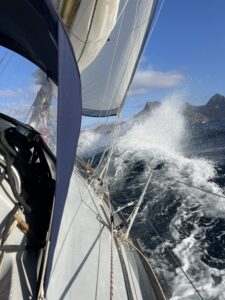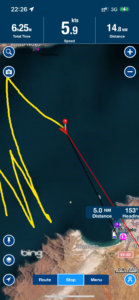
The Maritime Police arrived not in a coastguard cutter, nor even RIB with a pair of 90hp outboards and a blue light on the gantry.
Instead, they came chugging up in the little boat that takes the tourists to see the turtles.
But then, this was Bahia Sao Pedro at the south end of Sao Vicente in the Cape Verde Islands, where Thibaut and Cécile on Orion had written on Navily: “Pleasant anchorage. Frequent gusts but excellent holding in sand. Anchorage surrounded by green turtles. Keep your hands closed to avoid them mistaking your fingers for a piece of fish!”
They were right about the gusts. It took me as long to beat into the bay as it had to sail the six miles from Mindelo. By the time I had everything squared away, it was getting late. Never mind, I could swim in the morning.
However, the venue did not live up to its reputation.
First of all, the water wasn’t at all clear. I did see three turtles – all too deep to mistake my fingers for a piece of fish. Frankly, there were more interesting things growing on Samsara’s bottom.
Then the tour boat came by and informed me that I couldn’t anchor there. I told them I was leaving anyway.
They came back half an hour later. Instead of the tourists, this time with the Maritime Police.
Anchoring was forbidden, they informed me. The bay was not a designated port and they needed to see my ship’s papers along with the certificate of departure to my next port which I would have been given when I checked in.
Ah, slight problem, there. I hadn’t actually checked in. I was only here because a solicitor back in England wanted me to sign a document for the house sale. In the end, I did it with my finger on the pdf (which I could have done on mobile data without stopping at all – it still looked as though a spider with inky feet had crawled across the contract).
I tried to explain all this but I think a bit of it got lost in translation,
“You must go to Mindelo.”
But that’s into the wind…
“You must go. We will keep your papers.”
Now, here is an essential truth that holds good wherever you happen to be in the world. I have travelled far and wide and I know this to be true:
Never, ever argue with a policeman.
Especially if he has a gun.
So, instead I smiled. They told me their names were Alberto and George (they had them embroidered on their uniforms). They would see me in Mindelo. Everything would be fine.
Ah yes, but would it – once they realised I had been in the country illegally for two days?
As I watched the anchor chain crawling aboard, the blue 30metre marker disappearing into the chain locker, then the yellow-and-white 25metre, I began to worry in earnest.
Every cruiser knows the story of the sailor who put into a quiet bay in Samoa to fix his watermaker. It was the beginning of the global COVID lockdown and he was on his way to the Philippines with his Filipina girlfriend (it was the only country that would let them in). He called the Samoan coastguard and informed them that he would only be 24 hours and would not set foot on shore.
They didn’t reply.
Instead, they came and collected him and his girlfriend and threw them in jail – leaving the boat unguarded in the unprotected anchorage.
Pictures of their jail cell went viral – with half the comments pointing out that it was exactly the same sort of jail cell that Samoans had to put up with. What did they expect?
I wondered what a Cape Verde jail cell might be like. I used up a bit more mobile data emailing the OCC Port Officer for the islands, asking for advice. How much trouble did he think I was in? Maybe he knew Alberto and George – it was a small island. Should I suggest he might ask them to go easy on me?
At least it stopped me toying with the idea of doing a runner: I don’t know how many maritime authorities around the world are aware that the cash-strapped UK Maritime and Coastguard Agency has done away with their very grand cardboard-bound Part One Certificate for the Registry for Yachts. I’ve still got the original for Samsara issued in 1973 – you would think it belonged to the Queen Mary.
Now all you get is a sheet of paper. I keep a spare – just in case.
This meant that I didn’t really need to go back to Mindelo at all. I could just turn south west – next stop Grenada and show them the spare…
Except, for all that stuff about always complying with instructions from police officers – especially if they not only have guns but also a fast patrol boat that could catch me in a couple of hours and tow me back to that prison cell.
And even if not, was there some sort of international maritime black list? Would I arrive in the Caribbean to find myself instantly arrested and placed on a flight back to face Cape Verdean justice.
Better go back to Mindelo…
But the forecast had been for a northeasterly Force7. Then there was Anne Hammick in Atlantic Islands: “The Canal de Sao Vicente is notorious for its strong winds, the two islands combining to produce a classic venturi effect.”
Apparently 10-15kts over the open ocean increases to gusts of 35-40kts in the channel.
So, if the forecasters expected 25-30kts over the open ocean…
I reefed. I reefed again. These weren’t gusts. This was a solid 30-35kts on the nose with a sea to match.
I stopped worrying about my prison cell and began wondering how long it was going to take me to cover the six miles this time.
The answer, since I know you’re dying to know, is twelve-and-a-half hours!
All right, it would have been a bit less if I’d had a proper chart instead of Google Earth and hadn’t confused the next headland with the next island – but that’s not the point. The point is that nobody decides to beat into a Force7-8 if they have any choice.
I didn’t. I “must go to Mindelo.” In a strange way, this was the best way to look at it. If there was no choice, I didn’t have to wonder whether it was wise, what might get broken – if there might be some shelter to be found on the way. I just had to go – bash, bash, bash…
Of course, if you are going to bash into a gale, there are few better boats for the job than the Rival 32.
Admittedly, one of them is the Rival 34 – the deep keel version. It was clear early on that while the 32 with her 1.4m draft, was ideal for creeping into small coves and the like, she does make a lot of leeway when hard on the wind. I have never actually measured it – that would be too depressing. Suffice it to say that, beating up the Canal de Sao Vicente, was one time I really wished I had a 1.8m draft.
Still, there was nothing to be done about that – and besides, the sun was shining, the air temperature was 26°C and the spray, when it caught me on deck, was a not-unpleasant 23°. It dried in five minutes. One way and another, I rather enjoyed myself.
Then the tide turned. This was a bit of a surprise. I had read in the book that in the Cape Verde Islands “Tidal ranges are small… tidal streams are also negligible…”
Had I been a bit more thorough and read on, I would have discovered “…but can run strongly in the passages between islands, particularly in the Canal de Sao Vicente where, combined with the ocean current, it may attain over four knots…”
After two tacks of three miles each, each taking an hour or so, I found myself precisely 0.86miles further up the channel.
After the next two, I had made another 0.21miles!

Clearly, this was going to take some time. I settled myself in the companionway with a kapok cushion to soften the sharp edges, I opened the Kindle and reminded myself that, with one or two notable exceptions, tides do not run in the same direction for more than six hours. All I had to do was keep going for longer than that.
The good thing about it all was that I was very familiar with the layout of Mindelo harbour after dark (complete with its unlit wrecks).
The last question was answered after I set the anchor and was walking back down the deck saying that I was damned if I was getting the table out for dinner.
The last question? What was going to get broken?
Answer: Another section of teak toe rail.
The knockdown had already destroyed about four metres, now a jib sheet must have got itself hooked round the protruding end of what remained and popped that off, too.
It could have been worse.
Nine o’clock in the morning found me in the immigration office. The officer was not remotely interested in my excuses. Instead, he gave me a form to fill in, pointed out that I had put my own name in the space for the boat’s name, stamped me in and immediately out again of the Republic of Cape Verde, and sent me round to the Maritime Police. There, George greeted me like a long-lost friend, produced my ship’s papers, added the missing Certificate of Departure for Grenada and wished me Bon Voyage for the crossing.
I felt it best not to complain about the twelve-and-a-half-hours and the missing teak rail.

Hi John, did you have engine problems or no fuel? Sympathico senior…all in a sailors strife.
No, neither
Good stuff!
Thank you John. Always entertaining.
Nick..(Sandwich, Kent)
What a “lovely” experience. Brilliant bit of reading. Thanks
John
Your adventures and story are just remarkable
All the best to you on your Atlantic Crossing
Vaughan, Ipswich, Suffolk
Love reading your blog!
Thank you –
Niko
I’m beginning to think you deliberately go looking for trouble in order to get hilarious copy for your blog and books! Shame you missed out on describing the inside of a Mindelo prison cell though
Thanks for all of your stories. I can’t wait until I’m out there.
great story, always love reading them, glad it worked out in the end, stay safe with those checkin-checkouts! 🙂